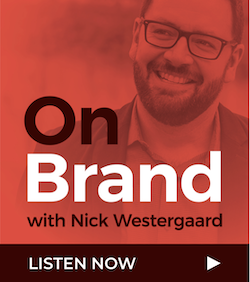Recently we’ve spent some time exploring what a brand is (and why it matters). We’ve also looked at the spark that gets your brand off the bench and into the game. Today I want to spend some time looking at the brand promise that should underly all of your marketing efforts online and off.
You Mean a Slogan, Right?
As we’ve said before, the labels in our industry — branding vs. marketing, connections vs. community — inherently suck. No where is this more apparent than in those words that accompany your logo. Are they your slogan? Your tagline? Your mission statement? These labels alone serve very different purposes.
The first two are predominantly promotional constructs. At best they are campaign slogans or something you roll out with a new visual identity. The latter (the mission statement) gets us a little bit closer as it relates more to what you do and how you do it — more on that in a bit. However, both sets of words are burdened with several branding booby traps.
When crafting slogans and taglines we tend to focus more on form rather than function. How does the proposed line sound — is it “catchy” enough? And what does it look like with the new identity? While a mission statement can often get lost in the tall weeds of intellectualism — We work to foster the ability to better understand the importance of XYZ and how the people of X and Y including but not limited to Z are impacted. Furthermore … You can imagine where it goes from here.
Again, each serves a very specific purpose, however, we need something different to anchor our efforts. In order to create a brand that stands for something, you need a clearly distilled statement of purpose to relate to your community to rally support and strengthen brand advocacy both internally and externally.
Why a Brand Promise?
In the HBO series Game of Thrones, there are several distinct and storied families or houses that make up the Seven Kingdoms of Westeros. Each house has unique characteristics — the Lannisters are rich and “always pay their debts” while the Starks are humble and honorable (to a fault, some might say).
It’s not that far fetched to draw similarities between the houses of the Seven Kingdoms and brands. Each house has a sigil or a visual symbol not unlike our logos in business. The Lannisters have a lion, the Starks have a direwolf, the Targaryens a dragon, the Baratheons a stag and so forth. Each house also has a set of words that communicate their message. The Lannister words are Hear Me Roar! while the Starks ominously observe that Winter Is Coming.
The houses of Westeros make the case that strong brands are represented by both icons and words. You could easily categorize this into the slogan/tagline category but I believe it’s an opportunity to say something bigger.
Brand Promise Formula
The construct of a brand promise works for many reasons. Like any good descriptor, all of the words work hard for the money. First, by including the word brand as part of our label it makes it clear that, more than being a mindless slogan or nice-looking words to sit below our logo, these words function in service of the brand. Second, rather than the carelessness implied with the word tagline, the construct of a promise endows these words with a greater purpose.
Who is this a promise between? Between your brand and those you serve. That’s the other power implied in the word promise. It brings the most important player to the table — your stakeholders. It’s easy in design exercises to focus on the words that look right or the ones that will please all of the really intelligent people on your board, if you are struggling with the mission statement label.
The construct of a brand promise also comes with a formula that connects you and your community. Simply put, your brand promise is: What You Do for Whom. This takes the bold catchiness from the tagline school of thought and reinforces it with the essence of the mission. And while you can wordsmith it all you want, most of us can fill in the blanks of this very basic formula. Take our brand, for example.
Earlier when I introduced the concept of the brand spark, I encouraged you to think of the action words that get you and your brand out of bed each day. With our organization, everything we do from blogging to teaching to consulting to live events is centered around the spark of helping. Adding another layer onto that spark creates our brand promise: Building Better Brands Online. This unifies our efforts, communicates our ethos (both internally and externally), and helps guide future work and development.
You’ll notice this is an expression that is very publicly a part of our brand (it’s on our website homepage, the back of our businesses cards, signage, etc.) but your brand promise doesn’t necessarily need to be customer facing. For example, Nike has had many customer facing slogans including the iconic Just Do It. However, these phrases have been marketing taglines as opposed to their brand promise: To bring inspiration and innovation to every athlete* in the world. The asterisk then goes on to note that “If you have a body, you’re an athlete.”
These words don’t always directly make it onto the front lines of their marketing but they do guide their efforts. They also function as the quintessential brand promise, stating what they do for whom. They also do it with a bit of attitude as noted in their asterisk.
Other brands use different words built on the same theme. We all know that Zappos was built on founder Tony Hseih’s desire to deliver happiness, as his book of the same title states. However, Zappos’ customer-facing slogan on their website notes that they are Powered by Service. These words are forged in the image of their core promise but are applied differently based on context.
Does It Really Matter?
In the end, you could be tempted to simplify the point. “We get it. You should have some good words along with your logo.” While this is true, it lacks the specificity of a brand promise. To build our brands we must make a solemn promise to those we serve. If the paying customers aren’t at the end of what we’re doing at every level, then we’re spinning our wheels.
Again, this has internal and external outcomes, as the promise helps you build stronger brand advocacy among your external customers and your internal team members and partners. The appropriately articulated brand promise should be the keystone that connects every aspect of your brand — from new product development to marketing and sales to on-going customer support and engagement.
Remember, your brand isn’t what you sell, say, or do. It’s what you believe. The best way to unite your internal and external community around what your brand believes is to make them a promise. In addition to building your brand, this is also a key step in building trust, which remains one of the most critical building blocks in strengthening relationships online and off.
What’s your brand’s promise? What do you do for whom?
Editor’s note: This is the third in a series of posts on how to build a better brand in the digital space. Subsequent posts will focus on utilizing the appropriate digital touch points to bring your brand to life.
Want More Updates from Brand Driven Digital?
Sign up for our email updates and you’ll never miss new content like this.
[sc:mailchimp]









